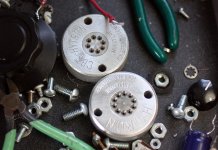Well the NOS tubes I previously bought from another company despite being in really old paper box still had clear and clean lettering, after much use on my amp the lettering faded over time, maybe from heat and possibly my handling? I just wasn’t expecting a NOS lettering to look this worn down from storage(kind of like a shirt, storing has minimal effect to the print, but usage does) but again I’m not familiar with tubes. That’s why I’m asking you guys.
I check the pins, some are bent but it looks alright. Comparing it to the pins of my used tubes, it looks almost identical, just has more oxidation.
I check the pins, some are bent but it looks alright. Comparing it to the pins of my used tubes, it looks almost identical, just has more oxidation.
Those valves have no sign of wear. The boxes look genuine - fake boxes look less worn out. There is no way to test whether a valve is NOS.
For me, glass colour is a very rough guide to how much use a valve has had but even that can be misleading as different manufacturers used slightly different glass. Small signal valves don't discolour their glass very much anyway.
For me, glass colour is a very rough guide to how much use a valve has had but even that can be misleading as different manufacturers used slightly different glass. Small signal valves don't discolour their glass very much anyway.
The term NOS is used inflatorial those days. On ebay, there is a professional tube dealer who claims that all his tubes are NOS and measures often 150% of data-sheet values. Most of those tube have no own boxes- how could that be? The truth is: those tubes only measures NOS. And the boxes have not been stored when used. So in fact, those tubes are all used tubes (at least for me). The boxes of a true NOS tube may be damaged by storage in many different locations over dozen of years, but the inner details and measurements should be first class (I dont know how a tube can manage to have 150% of datasheed values but im no expert on this topic). Most of the NOS boxes and tubes I bought look exactly like yours. Its more suspect when a 60 year old box isnt wornt out- that means mostly, its a fake box. Use your nose and smell within the box- it must smell like mud from the old paper. I would only judge by the combination of original box (must be a little worn or yellowed over the years) and correct tube inside, matching of box number and tube is important, too (if stated). In your case it seems an all original NOS tube with the correct original box. Chalk writing on tube is most often faded, that means nothing and will be another mark for NOS. If its not faded, than I would worry more because its easy to fake, too and than it looks brand new but its a fake. You cannot expect a 60 year old tube with box look like the same as they were in the tube-store in the year 1955. Those times are over.
Last edited:
Most of those tube have no own boxes- how could that be? The truth is: those tubes only measures NOS. And the boxes have not been stored when used. So in fact, those tubes are all used tubes (at least for me). The boxes of a true NOS tube may be damaged by storage in many different locations over dozen of years, but the inner details and measurements should be first class (I dont know how a tube can manage to have 150% of datasheed values but im no expert on this topic).
Loads of tubes got delivered in big boxes as lots to companies buying in quantity. You see grid boxes like that on eBay. No individual packaging, that was only for radio shops selling single pieces.
What's in the datasheet is an average value and a tube can have 150% of that average emission. It's also a question of what the used tester gives. If it's just a simple emission tester with a percentage scale it can mean anything unfortunately.
Last edited:
OK, I forgot that tubes were sold as bulk.
Its just that professional tube dealer who has in 99% of his sold tubes no boxes but a remarkable tester output of always more than 100% emission. Its quite difficult to test a tube with a neutral method it seems. So I always try to buy real NOS tubes which have exactly zero hours of operational pre-life (maybe just for testing purposes in the works).
Its just that professional tube dealer who has in 99% of his sold tubes no boxes but a remarkable tester output of always more than 100% emission. Its quite difficult to test a tube with a neutral method it seems. So I always try to buy real NOS tubes which have exactly zero hours of operational pre-life (maybe just for testing purposes in the works).
Those tubes look unused to me. On a tube that tends to run hot like the 12B4 the yellow Sylvania paint will quickly turn a brownish mustard color.
My 13GB5 / XL500's turned within a few hours of operation within the specs, but they get a bit hotter than 12B4's. 6CG7's can still be yellow after a few weeks, but still be darker that a new out of the box tube from the same NOS batch.
Sylvania has used slightly different shades of yellow over the years, but usually darken with use.
My 13GB5 / XL500's turned within a few hours of operation within the specs, but they get a bit hotter than 12B4's. 6CG7's can still be yellow after a few weeks, but still be darker that a new out of the box tube from the same NOS batch.
Sylvania has used slightly different shades of yellow over the years, but usually darken with use.
A bit off topic: The Hartmann&Braun 55a tube tester built for the German postal service had an extra part to "burn in" loads of fresh tubes so emission would stabilise and proper readings could be taken. That's pretty good practice but of course too much effort for tube dealers.
Last edited:
I would be suspicious of a dealer who only sells NOS with all better than 100% measurements. Two possibilities:
1. he is lying, and making up the test figures
2. he is an idiot, and throwing away any valves which test below 100% (or perhaps he thinks his customers are idiots and would reject any below 100%)
1. he is lying, and making up the test figures
2. he is an idiot, and throwing away any valves which test below 100% (or perhaps he thinks his customers are idiots and would reject any below 100%)
How do you do this, given that there is no test for NOS?So I always try to buy real NOS tubes which have exactly zero hours of operational pre-life (maybe just for testing purposes in the works).
Posts like this are why I don't like selling tubes.
It's a $16 pair of 12B4s from a dealer, not a pair of NOS WE 300Bs. You're buying/listening to the tubes, not the boxes. If you want, I bet you could send the pair back to the dealer, they could throw away the boxes for you, then send them back to you as "NOS from bulk packaging".


It's a $16 pair of 12B4s from a dealer, not a pair of NOS WE 300Bs. You're buying/listening to the tubes, not the boxes. If you want, I bet you could send the pair back to the dealer, they could throw away the boxes for you, then send them back to you as "NOS from bulk packaging".


Loads of tubes got delivered in big boxes as lots to companies buying in quantity. You see grid boxes like that on eBay. No individual packaging, that was only for radio shops selling single pieces...HI there k: re: post #12: I worked in a radio/tv wholesale dealers store HS classes and sometimes filled in during collage, (1956-1963). We had RCA and Sylvania boxed tubes shelved across a wall, forsale single box or pulled (often by me) in any quantity ordered across the counter or delivered. We never had any multitube matrix packages, although other shops may have had them. I occasionally visited other wholesale shops and they only had individual boxed tubs. ...regards, Michael
Loads of tubes got delivered in big boxes as lots to companies buying in quantity. You see grid boxes like that on eBay. No individual packaging, that was only for radio shops selling single pieces...HI there k: re: post #12: I worked in a radio/tv wholesale dealers store HS classes and sometimes filled in during collage, (1956-1963). We had RCA and Sylvania boxed tubes shelved across a wall, forsale single box or pulled (often by me) in any quantity ordered across the counter or delivered. We never had any multitube matrix packages, although other shops may have had them. I occasionally visited other wholesale shops and they only had individual boxed tubs. ...regards, Michael
It was mostly equipment manufacturers that would get the tubes in bulk. For them the box was a waste of money and served no purpose. That was not the case for the wholesale/retail replacement tube market vendors.
True, bulk pack was intended for equipment manufacturers and other large quantity users like the US government. Lots of these bulk packs wound up on shelves as required spare stock for military equipment. Some of it sat unused for as long as the original equipment was in use by the military. Once the equipment was removed from service, the spares were no longer required, and went to a surplus auction. I used to go to some of these auctions where there were literally hundreds of these bulk pack boxed being sold.
Anything, even large lots, where the individual tubes were intended to be sold singly, would be individually boxed, even if there were 100 individually boxed tubes inside a larger box.
Manufacturers would sell bulk packs, 100 tubes in 10 X 10 grid packs to avionics shops and military installations where equipment was re-tubed based on hours of use (flight time) whether needed or not.
Anything, even large lots, where the individual tubes were intended to be sold singly, would be individually boxed, even if there were 100 individually boxed tubes inside a larger box.
Manufacturers would sell bulk packs, 100 tubes in 10 X 10 grid packs to avionics shops and military installations where equipment was re-tubed based on hours of use (flight time) whether needed or not.
- Status
- This old topic is closed. If you want to reopen this topic, contact a moderator using the "Report Post" button.
- Home
- Amplifiers
- Tubes / Valves
- How worn out should NOS tubes look?

